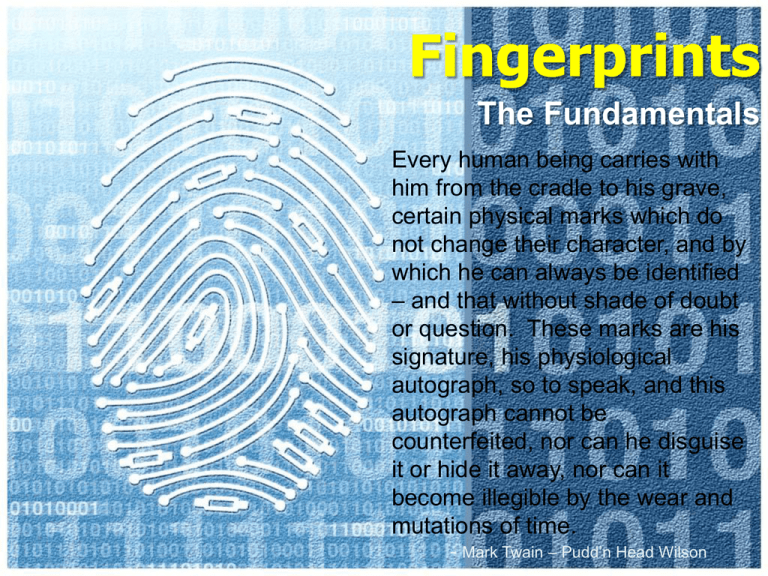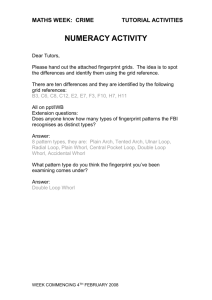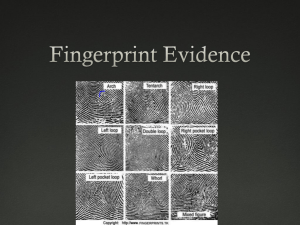Fingerprints
advertisement

Fingerprints The Fundamentals Every human being carries with him from the cradle to his grave, certain physical marks which do not change their character, and by which he can always be identified – and that without shade of doubt or question. These marks are his signature, his physiological autograph, so to speak, and this autograph cannot be counterfeited, nor can he disguise it or hide it away, nor can it become illegible by the wear and mutations of time. - Mark Twain – Pudd’n Head Wilson Works to Know • • • • • • • • • • • • Arch Core Delta Fingerprint Latent fingerprint Loop Minutiae Patent fingerprint Plastic fingerprint Ridge pattern Ten card Whorl Why do we have fingerprints? • Grip better • Makes perspiration easier on hairless surface • Improves sense of touch Fingerprints • Impression made by ridge patterns on the tip of a finger. • Consists of 98.7% water and 1.3% other substances (amino acids and salt) • Ridge characteristics start to form around 10 weeks gestation and are fully formed at 14 weeks. Formation due to movement or pressure caused by fetus and mother. Fingerprint Principles According to criminal investigators, fingerprints follow 3 fundamental principles: 1. A fingerprint is an individual characteristic; no two people have been found with the exact same fingerprint pattern. a. Determined by ridge patterns called minutiae b. Average person has 150 individual ridge characteristics on 1 print Fingerprint Principles 2. A fingerprint pattern will remain unchanged for the life of an individual; however, the print itself may change due to permanent scars and skin diseases. a. Contains ridges (hills) and grooves (valleys). a. Ridges contain pores where perspiration is discharged. This and oils picked up from hair or face are what leaves impressions of prints behind. (latent prints) Fingerprint Principles 3. Fingerprints have general characteristic ridge patterns that allow them to be systematically identified. a. ridge characteristics are known as minutiae: ridge endings, bifurcations, enclosures, and other ridge details. b. These ridges are placed into 3 classes. Fingerprint Classes There are 3 specific classes for all fingerprints based upon their visual pattern: arches, loops, and whorls. Each group is divided into smaller groups as seen in the lists below. Arch Plain arch Tented arch Loop Radial Loop Ulnar loop Whorl Plain whorl Central pocket whorl Double loop whorl Accidentical Interesting Info Fingerprint Factoid: 65% of people have loops, 30 - 35% have whorls, and 5% have arches Did you know? Dactyloscopy is the study of fingerprint identification. Police investigators are experts in collecting “dactylograms”, otherwise known as fingerprints. Arches Arches are the simplest and least common type of fingerprints that are formed by ridges that enter on one side of the print and exit on the other. No deltas are present. Spike or “tent” Plain Arch Ridges enter on one side and exit on the other side. Tented Arches Similar to the plain arch, but has a spike in the center. Loops Loops must have one delta and one or more ridges that enter and leave on the same side. These patterns are named for their positions related to the radius and ulna bones. Delta Ulnar Loop (Right Thumb) Loop opens toward right or the ulna bone. Radial Loop (Right Thumb) Loop opens toward the left or the radial bone. NOTE: On the left hand, a loop that opens to the left would be an ulnar loop, while one that opens to the right would be a radial loop. Whorls Whorls have at least one ridge that makes (or tends to make) a complete circuit. They also have at least two deltas. If a print has more than two deltas, it is most likely an accidental. Plain Whorl Central Pocket Whorl Draw a line between the two deltas in the plain and central pocket whorls. If some of the curved ridges touch the line, it is a plain whorl. If none of the center core touches the line, it is a central pocket whorl. Whorls – Part 2 Double Loop Whorl Accidental Whorl Delta Delta Double loop whorls are made up of any two loops combined into one print. Accidental whorls contain two or more patterns (not including the plain arch), or does not clearly fall under any of the other categories. Identify each fingerprint pattern. Right Hand Left Hand Right Hand Right Hand Left Hand It’s time to make some prints! Avoid Partial Prints GOOD PRINT Get as much of the top part of your finger as possible! Directions 1st – Roll the “pad” portion of your thumb over the ink pad from the left side of your thumb to the right. You do not have to push down really hard! 2nd – Roll the “pad” portion of your thumb from the left side of your thumb to the right in the correct box on your paper to make a thumbprint. 3rd – Continue this process to make a fingerprint of all ten fingers on the “My Prints” worksheet. 4th –Use your notes and a magnifying lens to help you figure out what type of pattern is found in each of your fingerprints. Label each one with the pattern’s name. Find Your Henry – FBI Number • The first step to classifying fingerprints is to identify the presence of any whorl patterns. • A number is assigned based upon what finger the whorl is present. • Add a 1 to the denominator and numerator to avoid zeros. Right Right Left Left Index Ring Thumb Middle 16 8 4 2 Right Right Right Left Thumb Middle Little Index 16 8 4 2 Add a 1 to the numerator and denominator at the end. Left little 1 Left Ring 1





